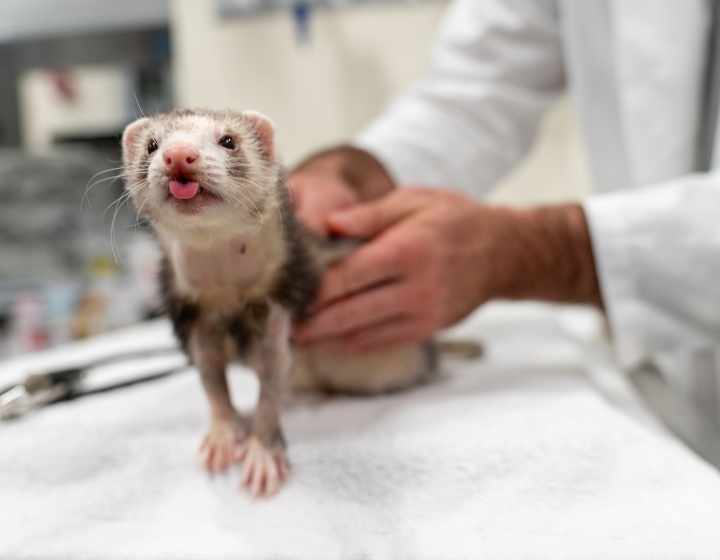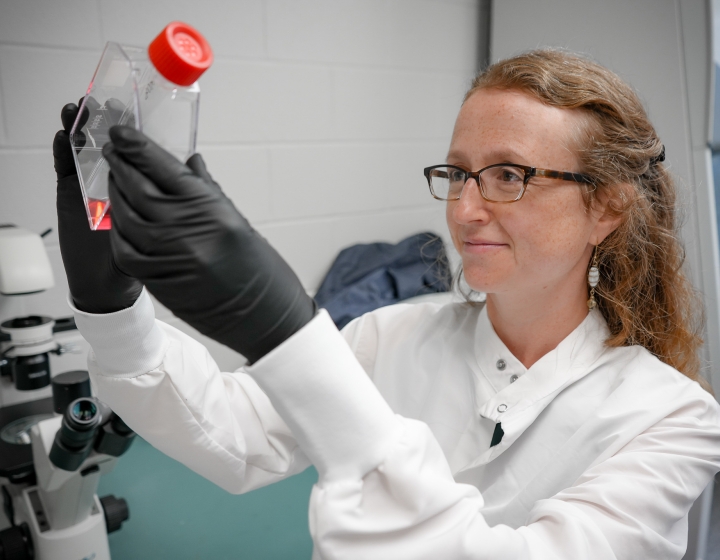Burnout takes a heavy financial toll on veterinary medicine
Workplace burnout is costing the veterinary industry two billion dollars a year, according to research from the Cornell Center for Veterinary Business and Entrepreneurship.
“Putting a price tag on how this very human issue affects veterinarians and technicians makes it tangible. Reality sinks in,” says Dr. Clinton Neill, assistant professor of veterinary economics and management, who leads the College of Veterinary Medicine’s research in this arena and authored a foundational study examining the economic cost of burnout.
Neill has long partnered with the American Veterinary Medical Association (AVMA) on much of this work. He recently joined them as a senior economist and associate director of strategic business research and outreach, in addition to his role at Cornell.
“When we hear about burnout, we don’t often understand the cost of it. That’s what’s been missing in our literature,” says Charlotte Hansen, economist and assistant director of statistical analysis at the AVMA.
Neill and Hansen say it is critical to demonstrate the financial side of workplace burnout to the veterinary industry so that organizations and practices across the country can start taking steps to alleviate the issue.
They use the World Health Organization (WHO) definition of workplace burnout: A syndrome “resulting from chronic workplace stress that has not been successfully managed.” An individual experiencing burnout might feel depleted energy levels, high exhaustion and cynicism toward the job. This could lead to poor performance, missing days, looking for new jobs or retiring early. In both human and veterinary medicine, burnout can lead to increased medical errors.
“It’s not good for medicine of any sort,” Neill says.
The $2B dollar figure comes from “The Economic Cost of Burnout in Veterinary Medicine,” published by Neill and his colleagues in the journal Frontiers in Veterinary Science in February. Two billion dollars in lost revenue is almost 4% of the industry’s entire value. The cost includes both veterinarians and technicians, each accounting for approximately $1B of dollars lost per group.
Calculating burnout prevalence
Neill’s research showed that over half of veterinarians suffered from burnout. According to the AVMA, approximately 118,000 veterinarians worked in the United States in 2020, over three quarters of whom are AVMA members. He used 2016-2020 AVMA survey data comprising 15,315 responses to calculate burnout prevalence, turnover and reduced work hours. The authors cited other studies on the prevalence of burnout in the veterinary industry, which showed that burnout is higher among recent veterinary graduates; veterinarians with high veterinary educational debt; those who spent most of their time with cats and dogs; and among women. They also noted that burnout is more prevalent among associates in private practice.
“There’s actually a lower probability that you’re burned out if you’re a practice owner,” Neill says. “This is likely because by contrast you have more control over your hours and availability.”
Using the AVMA’s data and two common quality of life scales, Neill and his colleagues divided answers into three categories: No burnout, moderately burned out and severely burned out. He specified that these categorizations are important because workplace burnout is not a binary concept. “It’s a spectrum, with varying levels of contributing stress.”
Calculating costs
The researchers focused on calculating the cost for the “moderately burned out” and “severely burned out” categories, using a cost-consequence analysis that has already been established in human medicine. In the most basic terms, the analysis contains two key questions: How much revenue does someone bring to a practice and how much is lost when they leave?
Calculating for hours worked, how many dollars they bring in, turnover rate, training costs and other similar elements, Neill found that the cost of burnout per veterinarian ranges from $17,000-25,000 a year. This is a conservative estimate, he says, and that the reasonable cost is between two-thirds and three-quarters of a veterinarian’s salary.
“If the average practice brings in six or seven hundred thousand dollars a year, and I’ve got two burned out veterinarians, that could be costing me up to fifty thousand dollars,” Neill says. “That’s quite a bit of money in revenue and profit that can be affecting your business.”
As data-driven as this foundational study is, Hansen notes that there are some things one can’t measure in dollar amounts when workplace burnout occurs. “When you lose individuals who have been in the field for a long time — that knowledge base, that experience, that leadership — it’s a total loss,” Hansen says. “It’s an intangible but important human consideration.”
She says it’s crucial that the data fuel any research into this topic, so that any solutions that spring from it have a solid foundation. “It’s a commitment that the AVMA takes seriously and our partnerships with third parties, including Cornell, increase the richness of that data.”
Contributing factors

There is no single smoking gun causing workplace burnout. “There are multiple factors that contribute to a person’s burnout levels,” Neill says. “For veterinarians, debt especially is an additional stressor for mental health.”
When factoring in licensed veterinary technicians, the elements contributing to burnout vary slightly. “The burnout component is the same, though they are usually more client-facing,” Neill says. “If you think about pandemic changes like curbside vet service, they’re likely the ones adapting to and facilitating that as well.”
Hansen notes that workplace burnout is a larger phenomenon that’s not unique to the human health care and veterinary fields. “It’s everywhere,” she says. “We see it in education with teachers, among social workers, law enforcement.”
In terms of veterinary professionals, the main factor driving workplace burnout is a working environment where they repeatedly encounter long working hours, an animal’s death, unexpected patient outcomes, client complaints and more — all of which compound, making recovering from workplace burnout a challenge for any individual.
Burnout rates were high even before the coronavirus pandemic hit, and data coming out now shows that it worsened the issue, Neill adds. “The Great Resignation, or the Great Reshuffling, that occurred across all industries in terms of labor did not skip veterinary medicine,” he says. “Although the pandemic’s effect on turnover is subsiding some, the health and well-being of the veterinary workforce is still a top issue for the profession.”
Seeking solutions
By providing data-driven research, the AVMA and its partners hope to create treatment plans for burnout at the organizational level, which Neill and others highlight as crucial to the ultimate success of mitigating the toll of workplace burnout.
“This is a workplace problem affecting the industry,” Neill says, “so we want to provide a different view of what it’s actually costing in terms of dollars — to understand it from an organizational standpoint, rather than telling individuals the burden is on them alone to address it.”
In the next phase of discovery, Neill and his colleagues have joined forces with Dr. Sunita Sah of the Cornell SC Johnson College of Business to find solutions to the issue of veterinary workplace burnout.
“If they implement the right interventions, managers can make a larger difference to alleviate burnout in their organizations than individuals can do on their own,” says Sah, who is director of the Cornell University Academic Leadership Institute and associate professor of management and organizations.
Hansen, who will also collaborate on this phase of the research, agrees. “We must move from individual solutions, because they don’t impact the widescale,” she says. “Burnout isn’t just a feeling someone can eventually get over on their own. It will take a system-wide change to alleviate it.”
The researchers suggest that veterinary medicine take lessons from human medicine, which has successfully demonstrated a two-pronged approach of addressing work-related issues and providing support for an individual’s personal life.
“For work solutions, managers can improve their communication and teamwork processes to facilitate discussion of how best to work and overcome problems,” Sah says. Open communication can lead to improvements that serve everyone, while also creating a psychologically safe environment for employees to express concerns without fear of retaliation, she adds. “Work environments that are perceived by the team to be psychologically safe have been shown to have less stress, turnover and burnout.”
Neill agrees that applying certain models from human health care to veterinary medicine in a systemic, cross-industry way could be key, and that the pandemic’s effects on the field could be an opportunity to think about how we work in a fundamentally different way.
Ultimately, this research is laying important groundwork on burnout for industry-wide change. Neill and his colleagues anticipate that the eventual steps the industry takes to address burnout will have a much more affordable economic cost than burnout itself. For now, however, they are letting that price tag sink in for the field at large.
Says Neill, “It’s costing your business money. That’s a really tangible thing for people.”
Support for this and upcoming studies was provided by the AVMA and Zoetis.
Written by Melanie Greaver Cordova





